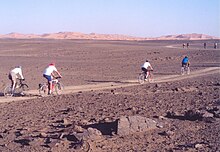Hamada
A hamada (Arabic: حمادة, ḥammāda) is a type of desert landscape consisting of high, largely barren, hard rocky (basalt) plateaus, where most of the sand has been removed by deflation.
[2] Hamadas are produced by the wind, which removes the fine products of weathering, an aeolian process known as deflation.
At the same time, the sand is removed through saltation and surface creep, leaving behind a landscape of gravel, boulders and bare rock.
[3] Hamada is related to desert pavement (known variously as reg, serir, gibber, or saï), which occurs as stony plains or depressions covered with gravels or boulders rather than as highland plateaus.
[1] Hamadas exist in contrast to ergs, which are large areas of shifting sand dunes.



